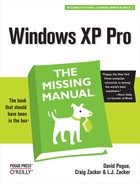Windows XP is by far the most internationally oriented version of Windows to date. It can accommodate any conceivable arrangement of date, currency, and number formats; comes with fonts for dozens of Asian languages; lets you remap your keyboard to type non-English symbols of every ilk; and so on.
For the first time in Windows, you can install multiple input languages on your computer and easily switch between them when the mood strikes (see Section 5.4 for details about the Language bar). The key term here is input language; the language for the operating system doesn’t change. If you installed Windows XP in English, you’ll still see the menus and dialog boxes in English. But when you switch the input language, your keyboard will type the characters necessary for the selected language.)
If you think that 7/4 means July 4 and that 1.000 is the number of heads you have, skip this section.
But in some countries, 7/4 means April 7, and 1.000 means one thousand. If your PC isn’t showing numbers, times, currency symbols, or dates in a familiar way, click the Customize button to rearrange the sequence of date elements (see Figure 8-18).
Tip
The Customize Regional Options box (Figure 8-15, left) is where you can specify whether you prefer a 12-hour clock (“3:05 PM”) or a military or European-style, 24-hour clock (“1505”).
The symbols you use when you’re typing in Swedish aren’t the same as when you’re typing in English. Microsoft solved this problem by creating different keyboard layouts, one for each language. Each keyboard layout rearranges the letters that appear when you press the keys. For example, using the Swedish layout, pressing the semicolon key produces an ö—not a semicolon (;).
For a choice of keyboard layouts, use the Settings tab of this dialog box to install the appropriate driver. Click Details, click Add, and, in the resulting window, choose the languages you want (see Figure 8-19).
After installing more than one keyboard layout, you can switch between them in either of two ways:
Figure 8-19. Top: After you’ve added a couple of layouts to the Language tab, specify the one you want by choosing its name from the top drop-down menu. Bottom right: The Language bar is a floating menu bar that lets you know which keyboard layout you’re currently using—a useful reminder when your typing seems to be producing only bizarre symbols. It automatically appears on your desktop when you install a second input language. Bottom left: This dialog box appears; change the options, if you like, and then click OK.
Use the Language bar, a floating, ghostly menu that lets you switch keyboard layouts no matter what you’re doing on the PC (Figure 8-19, bottom).
Note
The Language bar also appears if you’ve turned on or installed handwriting-recognition systems, Microsoft speech-recognition systems, or additional input languages, including special input software designed to let you type Asian language characters.
You can also switch from one keyboard layout to the next by simultaneously pressing the left-side Alt and Shift keys. Clicking the Key Settings button at the bottom of the dialog box shown at top left in Figure 8-19 lets you change this key combination, or set up individual key combinations for each language layout you’ve installed.
Tip
To view your new keyboard arrangement, use the Character Map program described in Section 6.1.4.2.
The Languages Tab also offers checkboxes that let you install the additional software required to word process in right-to-left languages (Hebrew, Vietnamese, and so on) and East Asian languages (Chinese, Japanese, and Korean). Proceed at your own risk—these files consume about 250 MB of disk space.
When running certain programs that are written to display their menus and dialog boxes in other languages, you can, in theory, use these language conversion tables to help Windows XP correctly display those languages. Microsoft offers you the option of applying the settings to the current user account and to the default user profile. (You have to be an administrator [Section 17.3.4] to install or remove these conversion tables.)

